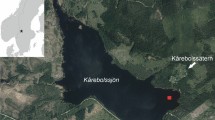Abstract
Pollen data are presented for the pine forest region around Lake Inari in eastern Finnish Lapland. The region has traditionally been the home of the Saami people who, until the 19th century, followed a seasonally nomadic way of life with an economy based on hunting, fishing and gathering. Although the Saami had no permanent centres of settlement, they did gather together at specific sites every winter, revisiting them year after year over several decades. A pollen diagram is presented from a peat area adjacent to one such winter village, Einehlammet. This shows a clear interference phase characterized by a peak in Ericales followed by a small but distinct peak in Poaceae and the slight, sporadic occurrence of pollen types that can be shown to be connected with human presence. At the same time Pinus values fall and, at the end of the phase, there is a strong increase in Betula pollen. This evidence is compared with that from actually within a dwelling (kota) at another winter village, Nukkumajoki, and is seen to follow exactly the same pattern. Such changes in forest composition in this situation could not be attributed to climatic change. The results demonstrate that, peoples pursuing a purely hunting and gathering economy and moving in the forests in a manner designed to preserve rather than destroy their environment can, nevertheless, cause vegetation changes that are discernable by pollen analysis within a distance of 50 m.
Similar content being viewed by others
References
Andersen ST (1988) Changes in agricultural practices in the Holocene indicated in a pollen diagram from a small hollow in Denmark. In: Birks HH, Birks HJB, Kaland PE, Moe D (eds) The cultural landscape: past, present and future. Cambridge University Press, Cambridge, pp 395–407
Aronsson KA (1991) Forest reindeer herding AD 1–1800. Archaeol Environ 10:1–125
Carpelan C (1991) Peuranpyytäjien talvikylä Inarissa [A wild-reindeer hunters' winter village in Inari]. Raitio 2/1991:20–28
Carpelan C, Hicks S (in press) Ancient Saami in Finnish Lapland and their impact on the forest vegetation. IBG monograph series
Carpelan C, Kankainen T (1990) Radiocarbon dating of a subrecent Saami winter-village site in Inari, Lapland, Finland: a preliminary account. Pact 29:357–380
Hicks S (1985) Problems and possibilities in correlating historical/archaeological and pollen-analytical evidence in a northern boreal environment: an example from Kuusamo, Finland. Fenn archaeol II:51–84
Hicks S (1993) The use of recent pollen rain records in investigating natural and anthropogenic changes in the Polar tree limit in northern Fennoscandia. In: Frenzel B (ed) Oscillations of the Alpine and Polar tree limits in the Holocene. Special Issue: ESF project, European palaeoclimate and man 4, Paläoklimaforschung 9:5–18
Hicks S (in press) Present and past records of Lapland forests. Rev Palaeobot Palynol
Hyvärinen H (1975) Absolute and relative pollen diagrams from northernmost Fennoscandia. Fennia 142:1–23
Hyvärinen H (1976) Flandrian pollen deposition rates and tree-line history in northern Fennoscandia. Boreas 5:163–175
Itkonen T (1948) Suomen lappalaiset vuoteen 1945 [Finnish Lapps up until 1945]. WSOY, Porvoo
Latalowa M (1992) Man and vegetation in the pollen diagrams from Wolin island (NW Poland). Acta Palaeobot 32:123–249
Seppälä M, Rastas J (1980) Vegetation map of northernmost Finland with special reference to subarctic forest limits and natural hazards. Fennia 158: Appendix
Simmons IG (1993) Vegetation change during the Mesolithic in the British Isles: some amplifications. In: Chambers F (ed) Climatic change and human impact on the landscape. Chapman and Hall, London, pp 109–118
Stuiver M, Reimer PJ (1993) Extended 14C data base and revised CALIB 3.0 14C age calibration program. Radiocarbon 35:215–230
Suominen J (1975) On the plant cover at sites of ancient Lapp winter villages, Finnish Lapland (In Finnish with English summary). Luonnon Tutkija 79:92–94
Tegengren H (1952) En utdödd lappkultur i Kemi lappmark [An extinct Lapp culture in Kemi, Lapland]. Acta Acad Aboensis Huminora 19:1–287
Author information
Authors and Affiliations
Rights and permissions
About this article
Cite this article
Hicks, S. Pollen evidence of localized impact on the vegetation of northernmost Finland by hunter-gatherers. Veget Hist Archaebot 2, 137–144 (1993). https://doi.org/10.1007/BF00198584
Received:
Accepted:
Issue Date:
DOI: https://doi.org/10.1007/BF00198584




